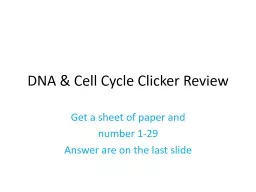

Get a sheet of paper and number 129 Answer are on the last slide 1 were credited for finding the structure of DNA Chargaff Franklin Watson amp Crick 2 What phase of Mitosis is this ID: 930790
Download Presentation The PPT/PDF document "DNA & Cell Cycle Clicker Review" is the property of its rightful owner. Permission is granted to download and print the materials on this web site for personal, non-commercial use only, and to display it on your personal computer provided you do not modify the materials and that you retain all copyright notices contained in the materials. By downloading content from our website, you accept the terms of this agreement.
Slide1
DNA & Cell Cycle Clicker Review
Get a sheet of paper and
number
1-29
Answer are on the last slide
Slide21. were
credited for finding the structure of DNA
Chargaff
Franklin
Watson
&
Crick
Slide32. What phase of Mitosis is this?
Prophase
Anaphase
Metaphase
Cytokinesis
TelephaseInterphase
Slide43. The
weakest bonds in a double-stranded molecule of deoxyribonucleic acid exist between the
deoxyribose
sugars
phosphate groups
nitrogenous bases5-carbon sugars
Slide54. Which
of the following activities occurs in the
S phase?
growth of the
cell
replication of the
DNA
formation of the mitotic
spindle
breakdown of the nuclear membrane
Slide65. Mutations
within a DNA sequence are
unnatural processes that are harmful to genetic diversity
natural
processes that produce genetic
diversityunnatural processes that always affect the phenotypenatural
processes that always affect the
phenotype
Slide76.
Which
of the following base pair sequences could be produced in DNA replication?
5' AGTCUT 3'3' TCUGTA 5
'
5' AGTCAT 3'3' CTGACG 5'5' AGTCAT 3'3' TCAGTA 5'
5
' AGTCAT 3'3' UCAGUA 5
'
Slide87.
A
student looking through a light microscope saw this cell in cytokinesis. This cell is most likely from —
a
plant
a virusAn animalA bacteria
Slide98.
The diagram is of an untwisted DNA molecule. Which part is the strong covalent bond?
A
C
E
FG
I
Slide109.
In
a molecule of double-stranded DNA, the amount of adenine present is always equal to the amount of
cytosine
guanine
thymineuracil
Slide1110.
The
diagram below shows Rosalind Franklin’s x-ray diffraction image of DNA
.
How did this evidence affect the work of Watson and Crick?
It was used to show that DNA was the molecule of inheritanceIt was used to develop the theory of independent
assortment
It was used to identify the four bases that make up
DNA
It was used to determine the physical structure of DNA
Slide1211.
During
DNA replication, the wrong nucleotide was inserted in the DNA sequence. Which of the following terms describes this situation?
mutation
regeneration
transcriptiontranslation
Slide1312.
studied
nucleotides
Chargaff
Franklin
Watson & Crick
Slide1413. What phase of Mitosis is this?
Prophase
Anaphase
Metaphase
Cytokinesis
TelephaseInterphase
Slide1514.
The
cell in the diagram below illustrates a stage of mitotic cell
division
Letter B indicates the
paired chromosomescentrioles
cell
plate
endoplasmic
reticulum
Slide165' G T A _ _ _ A
A
3'
3' C A T G C A T
T
5'15. This segment of DNA has undergone a mutation in which three nucleotides have been deleted. A repair enzyme would replace them withGTA
CTG
GCA
CGT
Slide1716.
Semi-conservative
replication of DNA refers to the idea that
each half of the original DNA molecule is joined with a new complementary DNA
strand
each new DNA molecule contains two new single RNA strandsDNA molecules need to unwind before duplication
begins
the two strands of DNA molecules run in opposite
directions
Slide1817.
Which
of the following activities occurs in the G1
phase?
growth of the
cell
replication of the
DNA
formation of the mitotic
spindle
breakdown of the nuclear membrane
Slide1918.
The diagram is of an untwisted DNA molecule. Which part is the
deoxyribose
sugar?
A
B C G
H
I
Slide2019.
The diagram below is the monomer of DNA. What is it?
Amino Acids
Fatty Acids
Monosaccharide
Nucleotide
Slide2120.
studied
DNA by using x-ray
diffraction
Chargaff
FranklinWatson & Crick
Slide2221.
A
portion of one strand of a DNA molecule has the sequence shown below.
ACCTGAAGG
Assuming there are no mutations in this portion of the DNA, what is the corresponding sequence on the complementary DNA strand?
TGGACTTCCUGGACUUCC
GTTCAGGAA
ACCTGAAGG
Slide2322.
Which
of the following features of DNA is
most important
in determining the
way an organism looks?the direction of the helical twistthe number of
deoxyribose
sugars
the sequence of nitrogenous
bases
the strength of the hydrogen
bonds
Slide2423. What phase of Mitosis is this?
Prophase
Anaphase
Metaphase
Cytokinesis
Telephase
Slide2524. Why must the cell divide?
Too many demands on DNA if to big
Hard to exchange material if to big
Volume increases more rapidly than the surface
area
All of the above
Slide2625. What phase of Mitosis is this?
Prophase
Anaphase
Metaphase
Cytokinesis
TelephaseInterphase
Slide2726.
Which
phase of mitosis would be seen
next?
[
Slide2827. What phase of Mitosis is this?
Prophase
Anaphase
Metaphase
Cytokinesis
TelephaseInterphase
Slide2928.
The diagram is of an untwisted DNA molecule. Which part is the weak Hydrogen bond?
A
C
E
FG
H
Slide3029.
The
period of time from the beginning of one cell division to the beginning of the next is called?
mitosis
S
phasecell cyclecytokinesis
Slide31Answers
:
C
B
C
BB
C
A
C
C
D
A
A
A
B
D
A
A
B
D
B
A
C
C
D
F
A
E
D
C